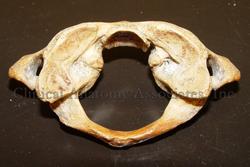| In Greek mythology [Atlas] is the son of Iapetus and Clymene, said to bear on his shoulders the weight of the world. Since the depiction of Atlas supporting the world appears in all early cartography books, these books were called atlases. With time, any book with a large number of pictures came to be known as an "atlas".
The [atlas] is a name used for the first cervicalvertebra, since this vertebra bears the weight of the head. The atlas is an atypical vertebra as it does not have a vertebral body and is composed by an anterior and a posterior arch. As a cervical vertebra, the atlas does have two lateral foramina transversaria, for the passage of the vertebral artery. The image depicts a superior view of the atlas and the articular surfaces for the atlantooccipital joint can be seen. If you hover over the image, a posterior view of the atlas will appear and you will see in the midline the articular surface for the atlantoaxial joint. For a larger version of both images, click on the legends below the image Images property of: CAA.Inc.. Photographer: D.M. Klein |
 |
| MTD Main Page | Subscribe to MTD |